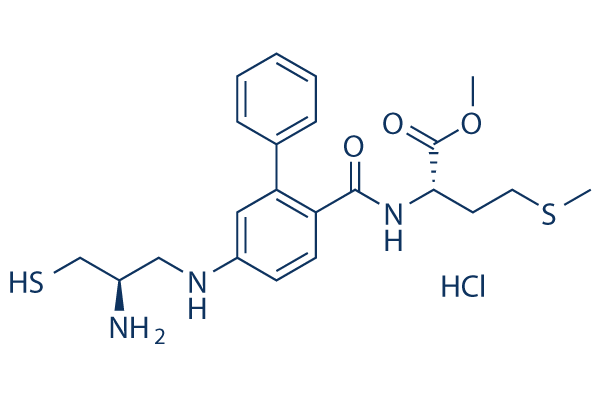| Cas No.: | 180977-34-8 |
| Chemical Name: | FTI-277 HCl |
| Synonyms: | FTI277,FTI-277,FTI 277 |
| SMILES: | Cl.CSCC[C@@](/N=C(/C1=CC=C(NC[C@@](CS)([H])N)C=C1C1=CC=CC=C1)\O)([H])C(OC)=O |
| Formula: | C22H30ClN3O3S2 |
| M.Wt: | 484.07 |
| Purity: | >98% |
| Sotrage: | 2 years -20°C Powder, 2 weeks 4°C in DMSO, 6 months -80°C in DMSO |
| Description: | FTI-277 Hcl is an inhibitor of farnesyl transferase (FTase); a highly potent Ras CAAX peptidomimetic which antagonizes both H- and K-Ras oncogenic signaling. |
| Target: | FTase inhibitor |
| In Vivo: | FTI-277 treatment prevented increased PTP-1B and PTEN protein expression in burned mice as compared with vehicle alone. In contrast, FTI-277 did not significantly alter protein expression of PTP-1B and PTEN in sham-burned mice [2]. |
| In Vitro: | Treatment with FTI-277 (20 microM) for 48 h prior to irradiation led to a significant decrease in survival of radioresistant cells expressing the 24-kDa isoform (HeLa 3A) but had no effect on the survival of control cells (HeLa PINA). The radiosensitizing effect of FTI-277 is accompanied by a stimulation of postmitotic cell death in HeLa 3A cells and by a reduction in G(2)/M-phase arrest in both cell types [1]. Treatment of PC-3 cells with GGTI-298 and FTI-277 inhibited migration and invasion in a time- and dose-dependent manner [3]. |
| References: | [1]. Cohen-Jonathan E, et al. The farnesyltransferase inhibitor FTI-277 suppresses the 24-kDa FGF2-induced radioresistance in HeLa cells expressing wild-type RAS. Radiat Res. 1999 Oct;152(4):404-11. [2]. Nakazawa H, et al. Role of protein farnesylation in burn-induced metabolic derangements and insulin resistance in mouse skeletal muscle. PLoS One. 2015 Jan 16;10(1):e0116633. [3]. Virtanen SS, et al. Inhibition of GGTase-I and FTase disrupts cytoskeletal organization of human PC-3 prostate cancer cells. Cell Biol Int. 2010 Aug;34(8):815-26. |

 DC Chemicals' products qualify for U.S. tariff exemptions. We guarantee no price increases due to customs duties and maintain stable supply, continuing to deliver reliable research solutions to our American clients.
DC Chemicals' products qualify for U.S. tariff exemptions. We guarantee no price increases due to customs duties and maintain stable supply, continuing to deliver reliable research solutions to our American clients.





















